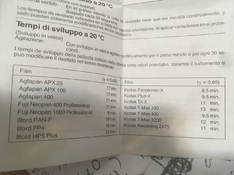Captain Mainwaring
Member
Ey up gentlebeings, I have something that’s made me scratch my noggin here. I have a mate who’s a bit of a hoarder, and he’s been kind enough to supply me with a pack of old Agfa Atomal, which I absolutely wouldn’t mind trying out, but as I checked the instructions, I got really puzzled by the unorthodox development times. This is the absolute first time with any developer (and I’ve used quite a few over the years) that the development times specified for lower-ISO films are consistently longer than those of higher-ISO films, as the picture demonstrates. 9.5 min for T-Max 400 and 13 for T-Max 100; 12 min for HP5 and 16 for FP4. Now, I have absolutely no reason to suggest people from Agfa would deliberately mislead the users of their products, but what‘s with lower-ISO film requiring more time in the brine than higher-ISO film? Everyone I’ve asked is just as clueless as I am.










 The thing is, though, there are no dilutions specified. Stock solution, package makes a liter. "To process a minimum of 10-12 films" without any indication of extended development time for subsequent rolls. It's exactly this—"Agfa technicians knew what they were doing" vs "this cannot be right," innit, but also very much a case of "if this is nevertheless right for whatever reason, I want to know why"!
The thing is, though, there are no dilutions specified. Stock solution, package makes a liter. "To process a minimum of 10-12 films" without any indication of extended development time for subsequent rolls. It's exactly this—"Agfa technicians knew what they were doing" vs "this cannot be right," innit, but also very much a case of "if this is nevertheless right for whatever reason, I want to know why"!

